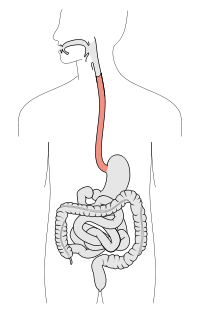
Photo from wikipedia
Gastrointestinal motility is impaired in a substantial proportion of patients with cirrhosis. Cirrhosis-related autonomic neuropathy, increased nitric oxide production, and gut hormonal changes have been implicated. Oesophageal dysmotility has been… Click to show full abstract
Gastrointestinal motility is impaired in a substantial proportion of patients with cirrhosis. Cirrhosis-related autonomic neuropathy, increased nitric oxide production, and gut hormonal changes have been implicated. Oesophageal dysmotility has been associated with increased frequency of abnormal gastro-oesophageal reflux. Impaired gastric emptying and accommodation may result in early satiety and may have an impact on the nutritional status of these patients. Small intestinal dysmotility might be implicated in small intestinal bacterial overgrowth and increased bacterial translocation. The latter has been implicated in the pathophysiology of hepatic encephalopathy and spontaneous bacterial peritonitis. Enhanced colonic motility is usually associated with the use of lactulose. Pharmacological interventions aiming to alter gastrointestinal motility in cirrhosis could potentially have a beneficial effect reducing the risk of hepatic decompensation and improving prognosis.
Journal Title: Gastroenterology Research and Practice
Year Published: 2017
Link to full text (if available)
Share on Social Media: Sign Up to like & get
recommendations!